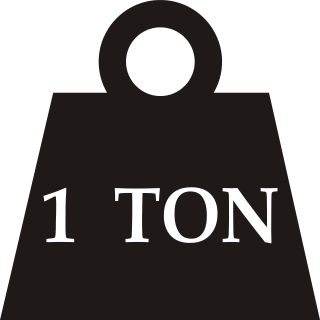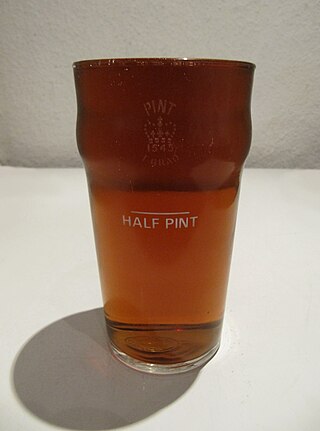Related Research Articles

The litre or liter is a metric unit of volume. It is equal to 1 cubic decimetre (dm3), 1000 cubic centimetres (cm3) or 0.001 cubic metre (m3). A cubic decimetre occupies a volume of 10 cm × 10 cm × 10 cm and is thus equal to one-thousandth of a cubic metre.

The pound or pound-mass is a unit of mass used in British imperial and United States customary systems of measurement. Various definitions have been used; the most common today is the international avoirdupois pound, which is legally defined as exactly 0.45359237 kilograms, and which is divided into 16 avoirdupois ounces. The international standard symbol for the avoirdupois pound is lb; an alternative symbol is lbm, #, and ℔ or ″̶.

Ton is the name of any one of several units of measure. It has a long history and has acquired several meanings and uses.
The foot (pl. feet), standard symbol: ft, is a unit of length in the British imperial and United States customary systems of measurement. The prime symbol, ′, is a customarily used alternative symbol. Since the International Yard and Pound Agreement of 1959, one foot is defined as 0.3048 meters exactly. In both customary and imperial units, one foot comprises 12 inches and one yard comprises three feet.

The cubic inch is a unit of volume in the Imperial units and United States customary units systems. It is the volume of a cube with each of its three dimensions being one inch long which is equivalent to 1/231 of a US gallon.

The pint is a unit of volume or capacity in both the imperial and United States customary measurement systems. In both of those systems it is traditionally one eighth of a gallon. The British imperial pint is about 20% larger than the American pint because the two systems are defined differently. Almost all other countries have standardized on the metric system, so although some of them still also have traditional units called pints, the volume varies by regional custom.
The rod, perch, or pole is a surveyor's tool and unit of length of various historical definitions, often between approximately 3 and 8 meters. In modern US customary units it is defined as 16+1⁄2 US survey feet, equal to exactly 1⁄320 of a mile, or a quarter of a surveyor's chain, and is exactly 5.0292 meters. The rod is useful as a unit of length because integer multiples of it can form one acre of square measure (area). The 'perfect acre' is a rectangular area of 43,560 square feet, bounded by sides 660 feet long and 66 feet wide or, equivalently, 40 rods and 4 rods. An acre is therefore 160 square rods or 10 square chains.

A barrel is one of several units of volume applied in various contexts; there are dry barrels, fluid barrels, oil barrels, and so forth. For historical reasons the volumes of some barrel units are roughly double the volumes of others; volumes in common use range approximately from 100 to 200 litres. In many connections the term drum is used almost interchangeably with barrel.
The units of measurement of German-speaking countries consist of a variety of units, with varying local standard definitions. While many were made redundant with the introduction of the metric system, some of these units are still used in everyday speech and even in stores and on street markets as shorthand for similar amounts in the metric system. For example, some customers ask for one pound of something when they want 500 grams.
Alqueire is a traditional unit of measurement in Portuguese. The term has been documented in Portugal since the 12th century. It is derived from the Arabic word أَكْيَال(al-kayl), which roughly means 'measure'. It was originally used to measure the amount of dry goods a pack animal could carry, in the form of satchels or baskets. In Portugal, the alqueire was used as a measure of capacity and eventually it was used also as a measure of area of productive land. The spread of Portuguese culture took both meanings of the word to different parts of the world.
Sangalhos is a town and a civil parish in the municipality of Anadia, Portugal. The population in 2011 was 4,068, in an area of 16.90 km².

Portuguese units were used in Portugal, Brazil, and other parts of the Portuguese Empire until the adoption of the metric system in the 19th century and have continued in use in certain contexts since.
The almude is an obsolete Portuguese unit of measurement of volume used in Portugal, Brazil and other parts of the Portuguese Empire.
Capacities of brewery casks were formerly measured and standardised according to a specific system of English units. The system was originally based on the ale gallon of 282 cubic inches. In United Kingdom and its colonies, with the adoption of the imperial system in 1824, the units were redefined in terms of the slightly smaller imperial gallon. The older units continued in use in the United States.
A Juchart was a unit of area measurement used in rural Switzerland until the early 20th century. In other German speaking regions it was known as a Joch, Jochart, Jauchart, Jauch, Juck or Juckert. The Juchart was a measurement of the amount of farm land that a man could plow in one day. It is similar to the northern German traditional measurement of a Morgen, which was approximately the amount of land tillable by one man behind an ox in the morning hours of a day. In the French speaking Canton of Vaud a related unit of acreage, the Pose was used.
Historical metrology is the science that is dealing with the fundamental units of measurement, systems of units formerly in use in various countries, and the development of monetary units throughout their history.
A number of different units of measurement were used in Brazil to measure quantities including length, area, volume, and mass as those units were derived from Portugal and had significant local variances.

The klafter is an historical unit of length, volume and area that was used in Central Europe.

De Rijn was an early Dutch, and later Prussian steamboat that plied the Rhine. On 17 October 1825 she was renamed Friedrich Wilhelm. In 1829 she was renamed Prinz Friedrich von Preußen, and in 1831 Prins Frederik. De Rijn was the fourth German steamboat that provided regular service on the Rhine.
References
- ↑ Wilhelm Hoffmann: Allgemeine Enzyklopädie für Kaufleute, Fabrikanten, Geschäftsleute, oder vollständiges Wörterbuch über den Handel, die Fabriken, Manufaturen, Künste u. Gewerbe. vol. 2, Verlag Otto Wigand, Leipzig 1848, p. 586
- ↑ Christian Noback, Friedrich Eduard Noback, p. 510
- ↑ Theodor Friedrich Schrader: Das Wichtigste der WechselKurse, des Münzwesens und der Maße und Gewichte. Julius Klinkhardt, Leipzig 1854, p. 28